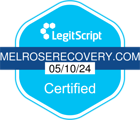Substance use and addiction are widespread in California. According to the California Health Care Foundation, half of Californians age 12 and older reported using alcohol in the past month. Twenty percent of people reported using marijuana in the past year.
Almost 2.9 million, or 9 percent of Californians, met the criteria for a substance use disorder or addiction. While many people use substances safely, abusing drugs and alcohol can lead to long-term health issues.
What are the most common addictions in California? What are the signs someone you know and love is struggling with an addiction? Knowing the signs of addiction and how Melrose Recovery can help may save your or a loved one’s life.
The California Health Care Foundation – Substance Use in California report found the following.
- Fentanyl deaths increased 10-fold from 2015 to 2019
- Prescription opioid deaths fell 30 percent from 2011 to 2019
- Amphetamine-related ER visits increased almost 50 percent between 2018 and 2020
- Non-heroin-related opioid ER visits doubled between 2018 and 2020
- Between 2017 and 2019, residential treatment centers increased by 68 percent
Addiction and substance abuse affects people all across the country. For those living in California, the following are the most common addictions in the state.
Alcohol Addiction
Alcohol is one of the most abused and deadly drugs. An average of 15,443 annual deaths in California are attributable to excessive alcohol use according to the National Center for Drug Abuse Statistics.
Because alcohol is legal, it’s easy to buy and socially acceptable at most events. Because alcohol is a widely abused legal substance, it is just as deadly as illegal drugs.
Alcohol use disorder involves trouble controlling drinking, being preoccupied with alcohol, and continuing to drink despite the problems it creates. It also means having to drink more and more to achieve the same effect and having withdrawal symptoms without alcohol.
Signs of alcohol addiction manifest through behavioral, physical, and psychological signs. Recognizing the signs can be crucial to getting help.

- Drinking more than intended or for longer than planned
- Needing to drink more to achieve the same effect
- Desiring to stop or cut down and failing
- Neglecting responsibilities at work and home
- Spending most of the time obtaining, using, and recovering from alcohol
- Avoiding social activities and hobbies that were once enjoyed
- Continuing to drink despite the consequences
- Needing to drink significantly more to feel the same effects
- Experiencing withdrawal symptoms such as shakiness, sweating, nausea, insomnia, anxiety
- Drinking to ease or avoid withdrawal symptoms
- Noticeable weight gain or loss
- Poor personal hygiene
- Redness in the face or eyes
- Strong urges or cravings to drink
- Mood swings when not drinking
- Blackouts or lapses in memory due to heavy drinking
- Justifying drinking habits as normal or necessary to cope with stress
Opioid Addiction
The California Health Department reports that overdose death rates including opioids increased by 33.2% between 2012 and 2021. The rise of opioid abuse over the past decade is alarming and highlights the need for early intervention and great access to opioid addiction treatment.
Street drugs like meth, cocaine, heroin, and MDMA are often laced with fentanyl. This cuts the cost and increases the potency of the drug. Most people are unaware that their drugs are laced with fentanyl, leading to fatal overdoses.
Signs of an opioid addiction include behavioral, physical, and psychological signs.
- Taking higher doses or more frequently than prescribed
- Using longer than intended
- Visiting multiple doctors for additional prescriptions
- Frequently requesting early refills
- Ignoring responsibilities at work, school, or home
- Avoiding social activities or once-enjoyed hobbies
- Isolating from friends and family
- Stealing or forging prescriptions to obtain opioids
- Using opioids despite the consequences
- Frequently nodding off
- Slurred speech and impaired coordination
- Changes in sleep patterns
- Significant weight loss
- Constricted pupils, even in low light
- Frequent symptoms such as nausea, vomiting, and sweating
- Visible needle marks on arms or other areas
- Extreme highs (euphoria) followed by extreme lows (depression)
- Increased nervousness and restlessness
- Trouble concentrating and making decisions
- Memory problems
- Intense urges to use opioids
- Justifying use as a necessity for pain relief or stress
Cocaine Addiction
The California Health Care Foundation reports that cocaine is the third most abused drug in California. More than 7.2 percent of the population uses it recreationally. Cocaine addiction accounts for 14 percent of treatment admissions every year.
Cocaine is a stimulant that produces a rush of energy. However, cocaine is highly addictive and can lead to mood changes, heart problems, addiction, seizures, and overdose.
Cocaine can lead to severe behavioral, physical, and psychological issues. Common signs include the following.
- Using larger amounts over time
- Frequent and compulsive use despite trying to stop
- Neglecting responsibilities at home, work, or school
- Declining performance and attendance
- Engaging in risky activities such as driving high
- Participating in illegal activities to get cocaine
- Isolating from family and friends
- Avoiding people and hobbies once enjoyed
- Financial trouble due to use
- Borrowing or stealing money to support the habit
- Irregular sleep patterns
- Extreme fatigue after use
- Significant weight loss due to lack of appetite
- Frequent nose bleeds and runny nose
- Damage to the nasal septum from snorting the drug
- Dilated pupils, even in bright light
- Elevated heart rate, blood pressure, and body temperature
- Poor hygiene
- Deterioration of overall health
- Intense feelings of happiness and high energy levels
- Rapid speech
- Overly confident
- Extreme highs followed by extreme lows
- Irritability
- Depression
- Suspicious and distrust of others without reason
- Seeing or hearing things that aren’t there
- Restlessness
- Nervousness or anxiety
- Strong cravings or urges to use
Meth Addiction
Meth addiction is one of the top addictions in California. In some areas, meth outranks opioids in fatal overdoses. ER visits due to crystal meth rose 600 percent in the last five years.
Meth can lead to serious health issues, such as damage to major organs, mental health issues such as paranoia, hallucinations, and fatal overdose. Recognizing the behavioral, physical, and psychological signs could save a life.
- Intense cravings and strong urge to use meth frequently
- Inability to stop or reduce use despite wanting to
- Neglecting responsibilities at home, work, or school
- Decline in attendance and performance
- Engaging in dangerous activities while under the influence
- Participating in illegal activities to obtain the drug
- Isolating from friends and family
- Avoiding once-enjoyed activities and hobbies
- Sudden mood swings
- Aggressive or violent behaviors
- Periods of extreme energy
- Restlessness
- Unintentional weight loss with decreased appetite
- Severe tooth decay
- Broken, stained, or missing teeth
- Persistent picking at the skin causing sores and infections
- Excessive itching causes scars
- Enlarged pupils, even in bright light
- Abnormal or rapid eye movements
- Neglecting personal hygiene
- Deterioration of overall appearance
- Intense happiness and invincibility
- Rapid speech
- Overly confident
- Extremely suspicious and distrusting
- Visual and auditory hallucinations
- Persistent nervousness and restlessness
- Irritability and trouble relaxing
- Trouble falling or staying asleep
- Staying awake for days followed by excessive sleep or “crashing.”
- Memory problems and difficulty concentrating
- Impaired judgment and decision-making
Marijuana Addiction
Using marijuana is legal in California. Nearly 35 percent of Californians use marijuana recreationally or medically. Abusing marijuana can cause mild symptoms such as drowsiness, disorientation, and increased heart rate. It can also impair judgment and cognitive function.
Marijuana can also be laced with fentanyl, increasing the risk of fatal overdose or death. This makes it essential to know the signs of marijuana addiction.
- Cravings and being preoccupied with obtaining and using marijuana
- Unable to control or reduce marijuana use despite wanting to
- Neglecting responsibilities at work, school, or home
- Declining performance and attendance
- Using marijuana in inappropriate situations
- Isolating from friends and family
- Using more to feel the same effects
- Irritability, restlessness, and anxiety without the drug
- Withdrawal symptoms such as headaches, sweating, and lack of appetite
- Bloodshot eyes and persistent cough
- Neglecting hygiene
- “Munchies” or eating more
- Altered sleep patterns
- Periods of euphoria followed by lethargy
- Irritable without the drug
- Memory issues, trouble concentrating, decreased attention span
- Impaired judgment and decision-making
- Feeling paranoid or intense anxiety
- Increased nervousness and restlessness
- Compulsive behaviors to obtain marijuana
- Strong urges to use
- Justifying use even when it causes issues
Inhalant Addiction
Inhalant addiction is often overlooked but is very serious. Inhalants are chemical vapes or gases that produce a “high” when inhaled. They include glue, gasoline, cleaning products, and aerosols. Inhalants are cheap and easy to get and have a high potential for abuse.
Inhalant abuse can lead to severe health problems, including:
- Sudden Sniffing Death Syndrome – heart failure
- Brain damage
- Organ damage
- Respiratory issues
Knowing the signs of inhalant addiction is crucial to getting immediate help. Common behavioral, physical, and psychological signs include the following.
- Household products disappearing without explanation
- Using inhalants more than normal
- Neglecting responsibilities at school, work, and home
- Declining performance
- Isolating from family and friends
- Avoiding social activities
- Using inhalants in hazardous environments
- Engaging in dangerous activities under the influence
- Strong chemical odors on breath or clothing
- Frequently using air fresheners to mask the smell
- Slurred speech, lack of coordination
- Nausea, vomiting, loss of appetite
- Frequent nosebleeds, sores, or rashes around the nose and mouth
- Red or runny eyes and nose
- Irritability, anxiousness, or depression without inhalants
- Euphoria followed by lethargy or depression
- Memory problems, trouble concentrating
- Confusion, disorientation
- Seeing or hearing things not there
- Extreme suspicion and distrust of others
Teens and young adults in California are increasingly using inhalants, including nitrous oxide or “nozz” and helium. Knowing the signs of abuse and getting them help can save them from serious health consequences and even death.
How Does Melrose Recovery Treat the Most Common Addictions?
Melrose Recovery provides comprehensive treatment programs to help individuals overcome addiction and regain control of their lives. Depending on the addiction, a detox program is often the first step in treatment.
Our detox program helps safely rid the body of drugs or alcohol. Once detox is complete, it is time to enter a treatment program and start your road to recovery.
- Residential Treatment – inpatient treatment with 24/7 supervision
- Aftercare – provides ongoing support and resources after completing a treatment program

Therapy is a crucial part of addiction recovery. At Melrose Recovery, we provide a range of therapies to meet each person’s needs. Types of therapies include:
- Cognitive Behavioral Therapy (CBT) – helps identify and change negative thought patterns and behaviors
- Dialectical Behavior Therapy (DBT) – teaches emotion management, reducing destructive behaviors, and improving relationships
- Motivational Interviewing (MI) – client-centered approach enhancing motivation to change
- Family Therapy – involves family members in the recovery process, improves communication, and rebuilds trust
- Group Therapy – individuals share experiences, gain insight, and receive feedback
- Experiential Therapies – uses activities and experiences to help explore emotions, develop new skills, and build self-awareness.
- Aftercare – long-term support and relapse prevention strategies to maintain lasting recovery
Finding Freedom From the Most Common Addictions AT Melrose Recovery
Are you or a loved one struggling with a drug or alcohol addiction? Have you tried to quit but go right back to using? At Melrose Recovery, our individualized treatment plans and dedicated team of professionals support you in finding lasting recovery. Contact us today to learn more.









